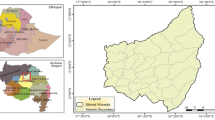Abstract
The relationship between two soil arthropod communities (Coleoptera and Isopoda) in organic and conventional fields was investigated. Soil arthropods were sampled by pitfall traps, and fuzzy set theory and canonical correspondence analysis (CCA) were used for their classification. The study was conducted in: (1) two organic and two conventional vineyards, (2) two organic and two conventional olive groves, and (3) one organic rotation system that involved maize and one conventional maize field. The species composition (three main fuzzy groups) was affected by the crop species and not by the farming system. The CCA placed the rare and unique taxa of soil arthropods at the edges of the diagram and grouped most of them together in relation to soil organic matter and Ca. The same analysis grouped all olive groves and related them to soil organic matter, all vineyards and related them to soil P and, finally, all maize fields and related them to soil N.
Similar content being viewed by others
Author information
Authors and Affiliations
Rights and permissions
About this article
Cite this article
HADJICHARALAMPOUS, E., KALBURTJI, K. & MAMOLOS, A. Soil Arthropods (Coleoptera, Isopoda) in Organic and Conventional Agroecosystems. Environmental Management 29, 683–690 (2002). https://doi.org/10.1007/s00267-001-0056-5
Issue Date:
DOI: https://doi.org/10.1007/s00267-001-0056-5




